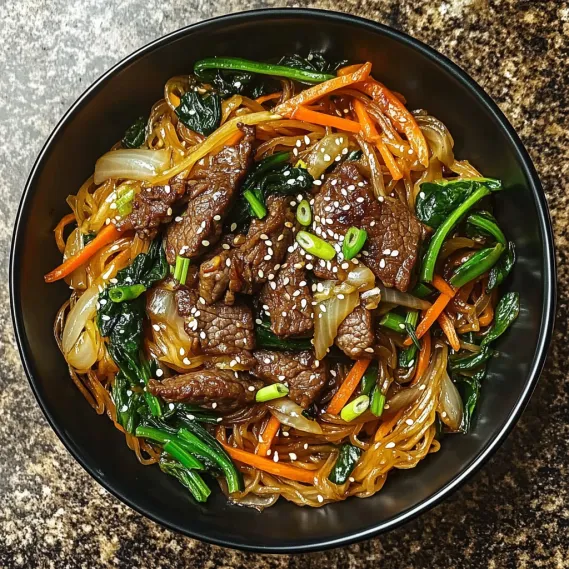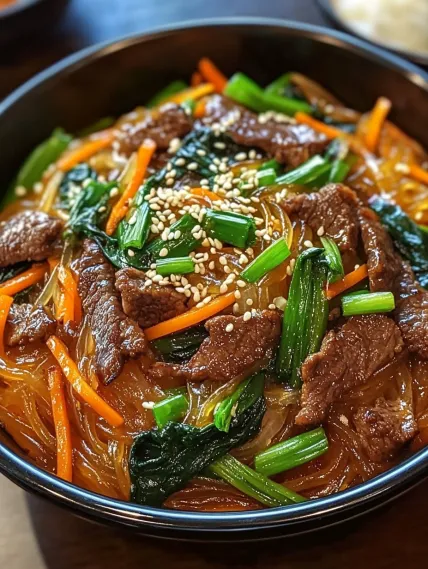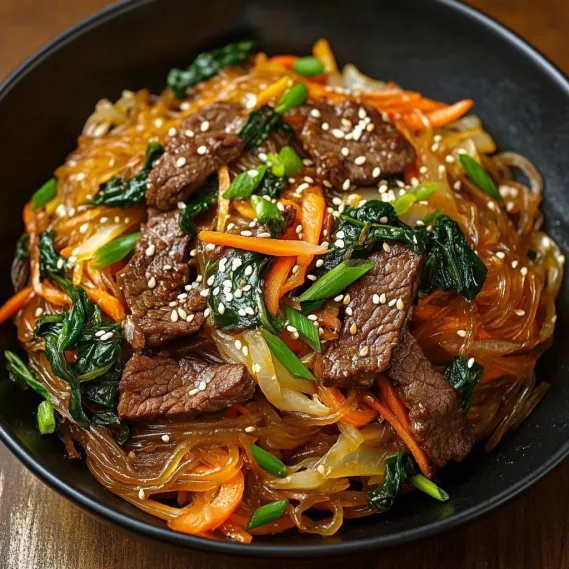 Pin
Pin
Japchae brings together chewy sweet potato glass noodles with tender beef strips and vibrant vegetables in a perfect balance of sweet and savory flavors. This traditional Korean dish features a delightful mix of textures - from the uniquely elastic noodles to crisp-tender vegetables and savory beef, all coated in a glossy sauce fragrant with sesame oil and soy sauce. The colorful mix of julienned carrots, spinach, and sliced onions not only makes this dish visually stunning but adds layers of nutrition and taste that will satisfy your hunger and curiosity for authentic Korean cuisine.
I first tried making japchae after returning from a trip to Seoul where I couldn't get enough of this noodle dish. My first attempt was a disaster - soggy noodles and overcooked vegetables. After several tries and learning from a Korean friend, I finally mastered the technique of cooking each component separately before combining. Now it's my go-to dish when hosting friends who are always amazed at the complex flavors despite the relatively simple ingredients.
Essential Ingredients and Selection Tips
- Sweet Potato Glass Noodles: These translucent noodles are the heart of the dish. Look for them in Asian grocery stores or online. Don't substitute with rice or wheat noodles as they won't provide the signature chewy texture.
- Beef: Thinly sliced ribeye or sirloin works best. Freeze the meat for 20 minutes before slicing to get paper-thin pieces that cook quickly and remain tender.
- Vegetables: Use a colorful mix including carrots, spinach, and sliced onions. Each vegetable should be cut to similar sizes for even cooking and visual appeal.
- Sesame Oil: This aromatic oil adds the distinctive nutty flavor essential to authentic japchae. Use pure sesame oil, not blends.
- Soy Sauce: Provides the savory foundation for the sauce. Use low-sodium versions if you're watching salt intake.
I've found that spending a little extra on good quality sesame oil makes a huge difference in the final flavor. The rich, toasty notes of a premium sesame oil elevate the entire dish and create that authentic Korean taste that keeps everyone coming back for seconds.
Detailed Cooking Instructions
- Step 1: Prepare the Noodles
- Fill a large pot with water and bring to a boil. Add the sweet potato noodles and cook for 5-6 minutes until they're tender but still chewy. Be careful not to overcook - they should maintain some resistance when bitten. Drain and rinse under cold water to halt the cooking process.
- Step 2: Season and Cook the Beef
- In a bowl, combine thinly sliced beef with soy sauce, sesame oil, and brown sugar. Mix well and let marinate for 10 minutes while preparing other ingredients. Heat a large skillet or wok over high heat and cook the beef until browned. Remove and set aside.
- Step 3: Prepare the Vegetables
- In the same skillet, add olive oil. Cook each vegetable separately: carrots first until slightly softened, then onions until translucent, followed by garlic, and finally spinach just until wilted. Remove and set aside each vegetable as it finishes cooking.
- Step 4: Create the Sauce
- In a small bowl, mix together the remaining soy sauce, sesame oil, and brown sugar until the sugar dissolves. This balanced sauce will coat all components with the perfect sweet-savory flavor that makes japchae so irresistible.
- Step 5: Combine Everything
- Return the noodles to the skillet over medium heat. Pour the sauce over the noodles and toss until well coated. Add the cooked beef, vegetables, and green onions, gently tossing everything together until well combined and heated through.
- Step 6: Final Seasoning
- Taste and adjust the salt as needed. The flavors should be well-developed and balanced, with tender noodles and savory beef.

My favorite memory with this dish was serving it at my daughter's graduation party. Several Korean guests approached me in surprise, saying it tasted just like their mothers' versions. The secret was cooking each vegetable separately to maintain vibrant colors and proper textures, then allowing the completed dish to rest for an hour before serving so the flavors could fully develop.

The Versatility of Japchae
Beyond its traditional preparation, japchae welcomes creative adaptations that can transform it from a side dish to a hearty main course. I've discovered that mushrooms make an excellent addition - especially shiitake, which adds a meaty texture and earthy flavor that complements the sweet-savory sauce beautifully. During summer months, I often add julienned bell peppers for extra crunch and color. For family gatherings where dietary needs vary, I prepare a large batch of noodles and vegetables, then offer protein options on the side - from traditional beef to chicken, shrimp, or tofu. This build-your-own approach has made japchae night a monthly tradition in our home, with everyone customizing their bowl to personal preference.
The Art of Perfect Noodles
Mastering sweet potato noodles took me several attempts before I understood their unique properties. Unlike wheat pasta, these noodles continue to absorb liquid long after cooking, which can lead to a soggy mess if not handled properly. My breakthrough came when I started cooking them just until al dente, then immediately rinsing under cold water to halt the cooking process. Tossing them with sesame oil not only prevents sticking but infuses them with flavor from the start. When adding the sauce later, I now heat everything just until warm rather than simmering, which keeps the noodles chewy instead of mushy. My husband, who initially preferred rice dishes, now requests japchae regularly, specifically mentioning the 'perfect noodle texture' as the reason.
Balancing Flavors and Colors
Traditional Korean cooking emphasizes balance not just in flavor but in color and nutrition - a concept called 'banchan.' I've embraced this philosophy when making japchae, ensuring that each vegetable isn't just there for taste but contributes to a harmonious color palette and nutritional profile. The deep green of spinach, orange carrots, and purple-white onions create a visual feast that signals the diverse nutrients in the dish. I've noticed that even my vegetable-resistant son eats everything in his japchae without picking anything out - the flavors work so well together that each component becomes essential to the experience. When teaching cooking classes at our community center, japchae has become my go-to demonstration for showing how thoughtful preparation enhances both presentation and flavor.
Cultural Connection Through Food
Preparing japchae has become more than just making a delicious meal - it's opened a window into Korean culture for our family. After learning the dish's origins as royal court cuisine during the Joseon Dynasty, we became curious about other aspects of Korean history and traditions. We now celebrate Korean holidays like Chuseok (harvest festival) with japchae as the centerpiece. My children have learned about the symbolic meaning behind the dish's colorful presentation - representing harmony and good fortune. What started as culinary exploration has evolved into cultural appreciation, with several Korean cookbooks now prominently featured in our kitchen and Korean dramas becoming our Friday night entertainment of choice.
Chef's Helpful Tips
- Prepare all ingredients before starting to cook - proper mise en place is essential for this fast-moving stir-fry
- For an authentic touch, garnish with toasted sesame seeds just before serving for extra nuttiness and visual appeal
- When cooking for a crowd, prepare components ahead of time and combine just before serving
- For a spicier version, add a tablespoon of gochujang (Korean chili paste) to the sauce
- If serving as a main dish, increase the protein to 2.5-3 pounds for 10 servings
I learned the importance of letting the completed dish rest after my first attempt resulted in a slightly dry texture. Those extra minutes make all the difference in the final creaminess of the dish.
Budget-Friendly Meal Planning
This dish exemplifies smart cooking economics, creating an elegant protein option when chicken breasts or steaks are on sale. When cube steak goes on sale, I buy extra and freeze portions specifically for this recipe. The remaining ingredients are pantry staples with long shelf lives, making this recipe perfect for creating restaurant-quality meals at a fraction of takeout prices.
Family-Friendly Adaptations
For households with varying preferences, this recipe offers easy customization. Children who might resist certain vegetables will often enjoy this dish since the pasta takes on the savory mushroom flavor. Add grated cheese on top for picky eaters, or incorporate additional vegetables like peas or corn for more nutrition. The basic recipe serves as a foundation that can be adapted to please everyone at your table.
Seasonal Vegetable Additions
This versatile main dish welcomes seasonal produce throughout the year. Summer brings opportunities for fresh corn on the cob or zucchini. Fall calls for roasted butternut squash or mushrooms. Winter versions incorporate hearty root vegetables. Spring welcomes tender asparagus tips and fresh peas. These adaptations keep the meal interesting year-round while making use of what's fresh and affordable at your market.
Make-Ahead and Freezer Tips
For busy households, this recipe shines as a prepare-ahead solution. The pasta and sauce can be made up to three days in advance and refrigerated. For longer storage, the completely finished dish freezes beautifully for up to three months. When ready to cook, thaw overnight in the refrigerator before baking as directed, adding 1-2 minutes to the cooking time.
Chef's Essential Tips
- For extra flavor, add a teaspoon of dried thyme or rosemary to the mushroom mixture
- Toast the potato chips lightly before using for added crispiness
- Add a pinch of cayenne pepper to the mushroom mixture for a spicy kick
- For a thicker sauce, mix 1 tablespoon cornstarch with 2 tablespoons cold water and stir into the sauce during the last 5 minutes
- The dish keeps well for leftovers and tastes even better the next day
I discovered these refinements over many iterations of this dish - particularly the addition of rosemary, which adds remarkable depth to the flavor profile without being identifiable as rosemary.

This versatile tuna noodle casserole has become my reliable go-to when I need a satisfying meal that pleases everyone. The combination of tender pasta, creamy sauce, and crunchy potato chips creates something greater than the sum of its parts - a dish that feels indulgent while being surprisingly simple to prepare.
This tuna noodle casserole recipe proves that delicious, satisfying meals don't require complicated techniques or hard-to-find ingredients - just thoughtful preparation of quality basics that come together in harmony.
Recipe FAQs
- → What are Korean sweet potato noodles and where can I find them?
- Korean sweet potato noodles (dangmyeon) are made from sweet potato starch and have a unique chewy, slightly elastic texture. You can find them at Asian grocery stores, Korean markets, or online. They're usually labeled as 'sweet potato noodles' or 'glass noodles.'
- → Can I make Japchae vegetarian?
- Absolutely! Simply omit the beef and add more vegetables like mushrooms (shiitake works great), bell peppers, or zucchini. You could also add tofu for protein. The flavor base of sesame oil, soy sauce, and brown sugar works wonderfully with just vegetables.
- → How do I store leftover Japchae?
- Store leftover Japchae in an airtight container in the refrigerator for up to 3-4 days. The noodles absorb the sauce over time, so when reheating, you might want to add a splash of soy sauce and sesame oil to refresh the flavors.
- → Why are my sweet potato noodles clumping together?
- If your noodles are clumping, they might be overcooked or left sitting too long after cooking. After boiling, rinse them under cold water to stop the cooking process, then toss with a small amount of sesame oil to prevent sticking. Only add them to the stir-fry at the very end.
- → Can I make Japchae in advance for a party?
- Yes! Japchae is actually often served at room temperature and tastes great made a day ahead. The flavors have time to meld together. Just store it covered in the refrigerator and bring to room temperature before serving, adding a drizzle of fresh sesame oil to revive the dish.
